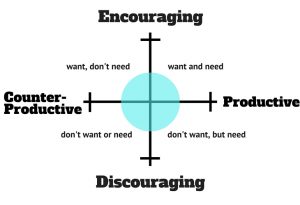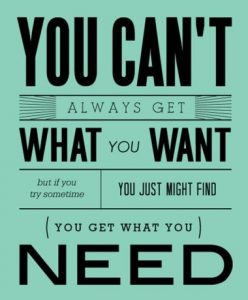Wants, Needs and Their Impact
Regardless of what age, race, gender or stage of life you are in, we all experience wants and needs. There is a continuous battle within us between these two. Our wants are the things that provide us with short-term gratification, while our needs are the things that provide us long-term gratification.

The end result of this interaction between wants and needs is dependent on how we respond to stimuli in our environment that trigger our behaviors. Wants are often associated with encouraging or discouraging triggers. Needs are associated with productive or counter-productive triggers. These four stimuli interact generating a situation as can be seen in the diagram.
We can be in multiple of these areas simultaneously, especially if we examine the different facets of our lives. Ideally, we would be in the top right corner the majority of the time. In a state in which we achieve short-term gratification and continue to strive towards our long-term desires. A good example of this would be going for a jog in the afternoon, releasing hormones providing us with immediate gratification as well as contributing towards a long-term of being healthy and fit.
Other times, we find ourselves in the “I want to, but I don’t need to” upper left quadrant. These are the situations that distract us from achieving our long-term goals. Probably the most common example plaguing college campuses right now is binge watching TV shows or movie series on Netflix or Hulu.
 Then again, sometimes the I “need to, but don’t want to” is at play. This is the most common case with rules. They exist to make sure we don’t immediately give in to all of our wants and limit our behavior so as to make sure they are directed towards our long-term goals. Varsity athletes are familiar with the occasionally implemented curfews, to ensure that they are getting rest before their big game. They may not necessarily want to be home, but in the long-term it will benefit them to be asleep.
Then again, sometimes the I “need to, but don’t want to” is at play. This is the most common case with rules. They exist to make sure we don’t immediately give in to all of our wants and limit our behavior so as to make sure they are directed towards our long-term goals. Varsity athletes are familiar with the occasionally implemented curfews, to ensure that they are getting rest before their big game. They may not necessarily want to be home, but in the long-term it will benefit them to be asleep.
The last and most treacherous of the interactions is the one in which the stimuli in our environment are both discouraging and counter-productive. These create the hopeless situations that make us feel apathetic, depressed, hopeless and isolated. These environments are dead-ends, to which our behaviors only make the situation more detrimental. In these situations it is important to make a conscious effort to escape the environment as soon as possible.
Though we encounter these four triggers on a daily basis, not everyone has the same responses or reactions to them. When we consciously manage our reactions, we can make the most out of even a bad situation. In the event someone is in the last quadrant, it is important to take the utmost advantage of our resources as soon as possible and get out and move on with our best foot, and our best behavior, forward.





